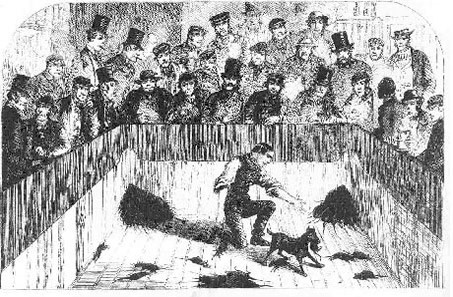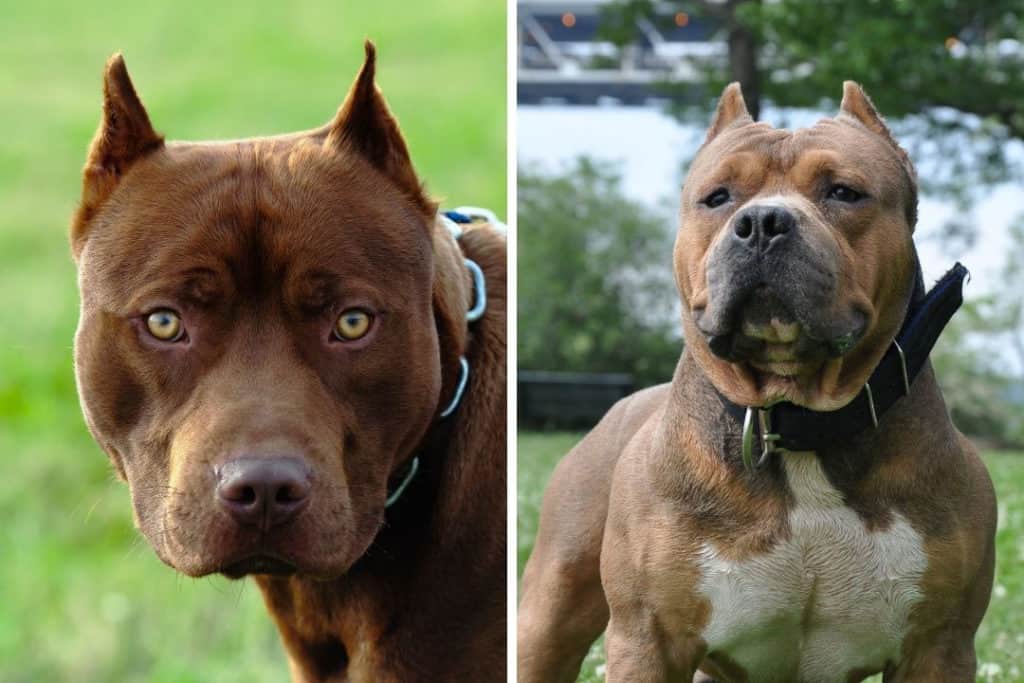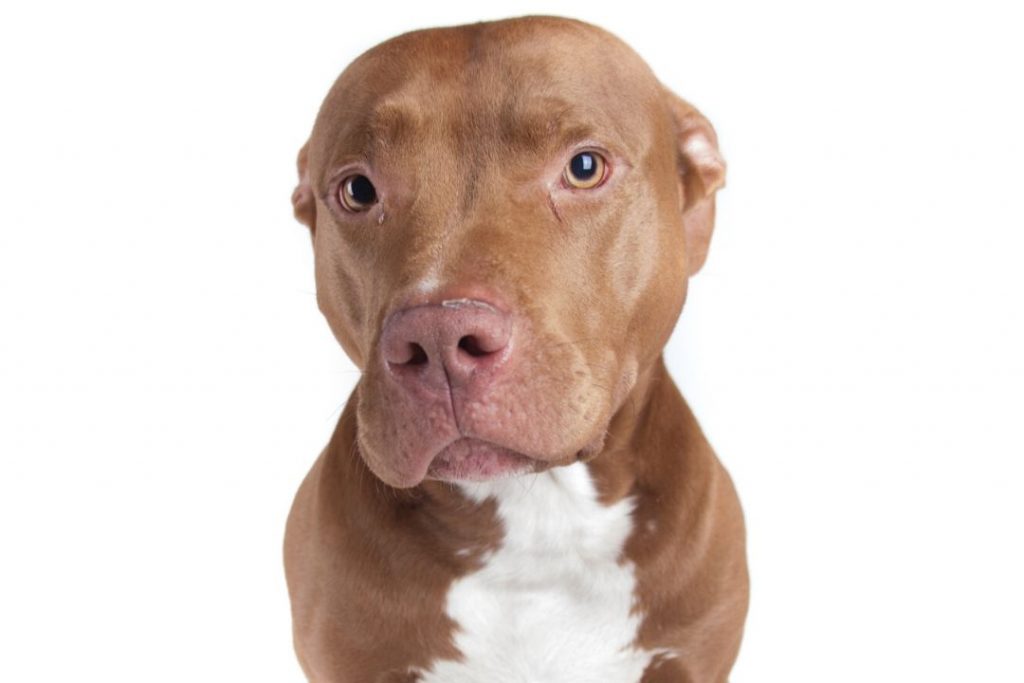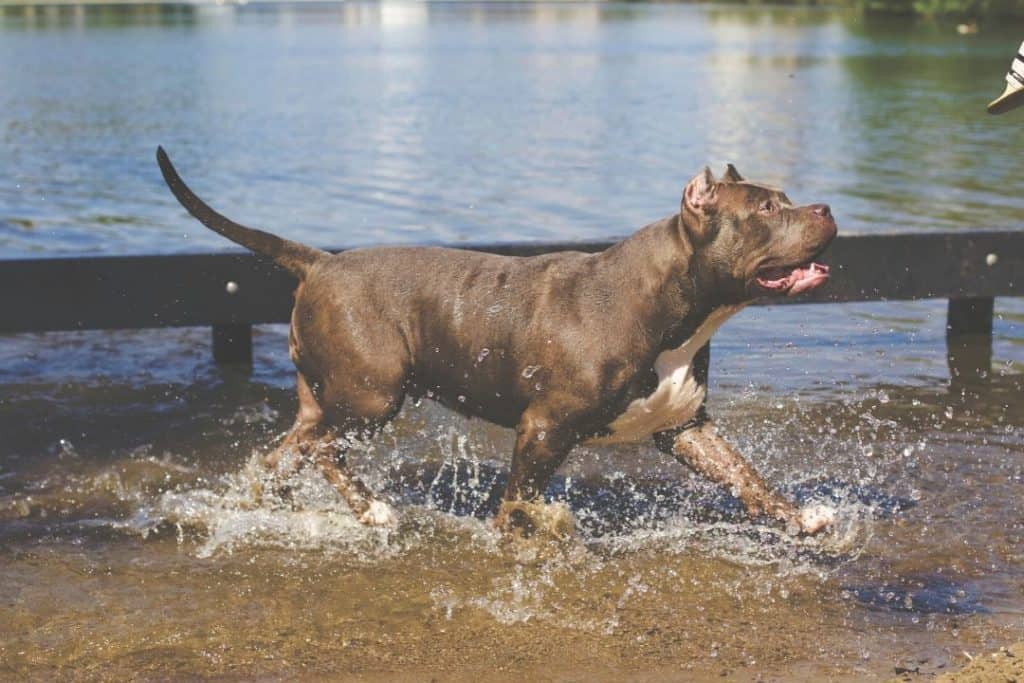This article may contain affiliate links, and I will be compensated if you make a purchase after clicking on my links (at no additional cost to you)
If you are in the market for a new four-legged companion, knowing the different breed types’ key differences is essential. For those exploring the attributes of a Pitbull vs. American Bully for your next dog, there are several factors to consider when making your choice.
Let’s take a look at a few key differences between the two seemingly similar breeds.
1. History of the Breeds
The term Pitbull stems from back in the 1800s. There was a game known as Bull Baiting, where a bull was secured to an iron stake and left with English Bulldogs as a gory game exhibition that isn’t exactly considered a proper form of entertainment in today’s times. Pitbulls were notorious for being fighting dogs, vicious in nature, giving them an aggressive rapport.

They were also used as livestock dogs, making their physique and disposition perfect for herding and guarding other animals. Since breeding was not as precise back in those times as today’s regulations, owners crossed the English Bulldogs with many terriers. This cross-breeding resulted in a wide variety of Pitbull Terriers that you see now.
The American Bully has gained popularity only in recent decades. Starting to appear between the 1980s and 1990s, the American Bully held characteristics as a companion that does not possess their ancestry line’s aggressive nature.
By combining the American Pitbull Terriers with the American Staffordshire Terriers, the American Bully was born. Although many people lump these dogs together in the same category, there are significant differences if you know what to look for.
2. Physical Differences
When exploring the Pitbull vs. American Bully differences in physical appearance, some features stand out, which indicate the type of dog. If you want to determine which type of canine it is, check out some of these tell-tale signs.
A Pitbull’s head is characteristically broad with blunt edging. The chiseled face gives an air of elegance and strength. Their muzzle is shorter, and the cheeks are predominately free of wrinkles, except in the forehead when they are deep in concentration.
The chest on a Pitbull is typically wide but is not as large as that of a Bully breed. The fore chest is level with the shoulders, making its appearance seem steady and strong. The body elongates towards the back, giving a long, sleek, and muscular look to their physique.
They are a muscular dog but look sleek and sophisticated since they are well-proportioned when analyzing the Pitbull vs. American Bully differences. Their legs are longer, making them taller and slender looking.
Pitbulls are a medium-sized dog and will grow to approximately 18 to 22 inches in shoulder height and weigh anywhere between 30 and 70 pounds. These attributes make them seem larger than their alternative, the American Bully, but it is not the case.
When comparing an American Bully to a Pitbull, the physical differences are striking. The American Bully has a large head, which can appear quite block-shaped. The well-defined face is sized appropriately to its body, and the muzzle is shorter than the skull, while the bottom jaw is often significantly developed. Its nostrils are larger and more open than a Pitbull’s.
The American Bully’s chest is notably wider, and it has a well-defined rib structure, where the fore chest does not extend past its shoulders. Their back is firm, strong, and wide, coupled with a great muscle structure. This combination gives this breed a more stocky or bulky look.
This breed has relatively shorter legs but can still grow in height between 17 to 20 inches above the shoulder area. Although this breed may seem smaller than the Pitbull, an American Bully can get much larger due to its muscular nature. Total weight for this breed can range from 30 up to a whopping 150 pounds.
3. Temperament
Potential owners should explore a dog’s temperament before deciding on a family pet or new four-legged companion. With proper training and structure, many dog breeds are perfect for a home situation, but owners should consider correct training methods and consistency.
Due to their historical background, Pitbulls have carried an aggressive breed trademark with them through the years. Although instinctive prey aggression is deeply-rooted in their genealogy, they can be terrific family dogs and loyal companions.
They are highly intelligent, and with extensive training and lots of bonding, Pitbulls can be a completely safe beloved pet for any home.
The Pitbull vs. American Bully differences in temperament comes with breeding. American Bully dogs are perfect companions due to their bright and friendly nature. They are curious, extremely intelligent, and are patient animals who love to please their humans.
4. Breed Variations
Before we dive into the specifics, the Pitbull breed does encompass a wide array of types that you may not be aware of.
The Pitbull breed is very diverse and includes 12 different types within this category, including:
- ‘Johnson’ American Bulldog
- Alapaha Blue Blood Bulldog
- ‘Scott’ American Bulldog
- American Staffordshire Terrier
- Dogo Argentino
- American Bully
- Boxer
- American Pitbull Terrier
- Bull Terrier
- Miniature Terrier
- Staffordshire Bull Terrier
- Boston Terrier
As you can see, the term Pitbull covers a vast array of dogs, and while some are similar in features and size, they are not, in fact, the same. Many individuals do get these two types of dogs confused due to several resemblances. When examining Pitbulls vs. American Bully differences, there are some distinct facts to keep in mind.
There is not much variation to this breed when comparing Pitbulls vs. American Bully differences. The Pitbull has a standard that encompasses a specific window of height and weight attributes and does not deviate much from it.
According to the American Bully Kennel Club, the American Bully is broken down into four separate categories, including:
- Standard
- Classic
- XL
As you progress through the variations, this breed will get larger in size and weight. Pocket American Bully dogs will still carry many of the same characteristics as the others but remain smaller in proportionate size topping out between 13 and 17 inches in height.

Standard and Classic variations are the most common today, which vary in height from 16 to 20 inches in total. The males will be slightly larger than the females, but both still carry a great muscular profile.
Topping the charts, the XL American Bully can reach between 19 and 23 inches of solid height and muscle. These variations are known to max out the scale anywhere between 150 to 200 pounds, making them a force to be seen.
The Takeaway
When you explore the Pitbull vs. American Bully differences, you can see how these four differences are key to determining exactly which type of dog it is. While many individuals lump all Pitbulls in the same category, it cannot be further from the truth. Many dog enthusiasts become exasperated with so much diversity in this breed that novices tend to generalize Pitbulls together.
After going through the numerous differences between the two types of dogs, many families will opt for an American Bully as their new family pet and lovable companion. Even though a Bully is a terrific choice, a Pitbull can also be a fantastic four-legged friend for families with children and individuals who are looking for a friendly pal.
With the correct training and structure, anyone can take a Pitbull or American Bully dog home and have the best friend imaginable for the next 11 to 13 years. Do not let breed speculation and poor history keep you from finding your next loyal companion in these dog breeds.

I created this blog to share my passion for bullies, and help current and future pitbull owners with things like diet and education.
Hope you find it useful, don’t hesitate to drop a comment on my articles!



